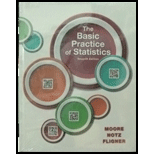
Concept explainers
a.
To find: All possible arrangements for selecting the three cups from six cups.
a.
Answer to Problem 12.50E
The all possible arrangements for selecting three cups from six cups
Explanation of Solution
Given info:
A Canadian friend, who is fond of tea, claims that it is possible to differentiate the taste of tea. While preparing tea, milk is added first and then hot tea is poured. The other way is hot tea is added first and then milk is poured. To prove the claim of Canadian friend, six cups of tea were prepared. Three of the cups were prepared using the first method and other three cups were prepared by using the second method. In a test, the friend is asked to find the three cups which had milk first and then hot tea poured into it.
Justification:
The sample space is defined as the set of all possible outcomes from an experiment.
There are six cups of tea, first three cups have milk added first and then hot tea poured into it. The remaining three cups have hot tea added first and then milk is poured into it.
Define
Define
Define
Define
Define
Define
It is mentioned that the three cups were first added with milk and then hot tea. Another three cups were first added with hot tea and then milk.
One way to select the three cups from the given six cups can be of milk first added in the first cup, milk first added in the second cup and hot tea first added in the first cup. That is,
Thus, the possible arrangements for selecting three cups from six cups are,
Thus, there are 20 possible selections to select three from six cups.
b.
To find: The probability that the Canadian friend identifies the three cups in which milk is added first.
b.
Answer to Problem 12.50E
The probability that the Canadian friend is identifying the three cups in which milk is added first is
Explanation of Solution
Given info:
Assume that the Canadian friend is just making a random guess.
Calculation:
The probability that the Canadian friend identifies the three cups in which milk is added first is calculated as follows:
The number of ways in which milk is added first in three cups are
Thus, the probability that the Canadian friend is identifying the three cups in which milk is added first is
Want to see more full solutions like this?
Chapter 12 Solutions
Bundle: Basic Practice of Statistics 7e & LaunchPad (Twelve Month Access)
 MATLAB: An Introduction with ApplicationsStatisticsISBN:9781119256830Author:Amos GilatPublisher:John Wiley & Sons Inc
MATLAB: An Introduction with ApplicationsStatisticsISBN:9781119256830Author:Amos GilatPublisher:John Wiley & Sons Inc Probability and Statistics for Engineering and th...StatisticsISBN:9781305251809Author:Jay L. DevorePublisher:Cengage Learning
Probability and Statistics for Engineering and th...StatisticsISBN:9781305251809Author:Jay L. DevorePublisher:Cengage Learning Statistics for The Behavioral Sciences (MindTap C...StatisticsISBN:9781305504912Author:Frederick J Gravetter, Larry B. WallnauPublisher:Cengage Learning
Statistics for The Behavioral Sciences (MindTap C...StatisticsISBN:9781305504912Author:Frederick J Gravetter, Larry B. WallnauPublisher:Cengage Learning Elementary Statistics: Picturing the World (7th E...StatisticsISBN:9780134683416Author:Ron Larson, Betsy FarberPublisher:PEARSON
Elementary Statistics: Picturing the World (7th E...StatisticsISBN:9780134683416Author:Ron Larson, Betsy FarberPublisher:PEARSON The Basic Practice of StatisticsStatisticsISBN:9781319042578Author:David S. Moore, William I. Notz, Michael A. FlignerPublisher:W. H. Freeman
The Basic Practice of StatisticsStatisticsISBN:9781319042578Author:David S. Moore, William I. Notz, Michael A. FlignerPublisher:W. H. Freeman Introduction to the Practice of StatisticsStatisticsISBN:9781319013387Author:David S. Moore, George P. McCabe, Bruce A. CraigPublisher:W. H. Freeman
Introduction to the Practice of StatisticsStatisticsISBN:9781319013387Author:David S. Moore, George P. McCabe, Bruce A. CraigPublisher:W. H. Freeman





